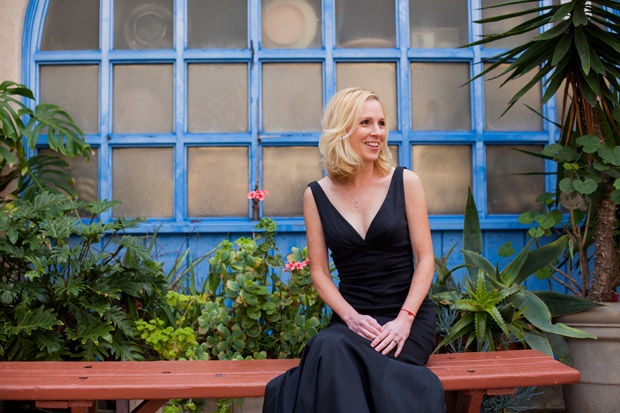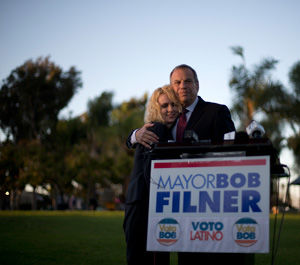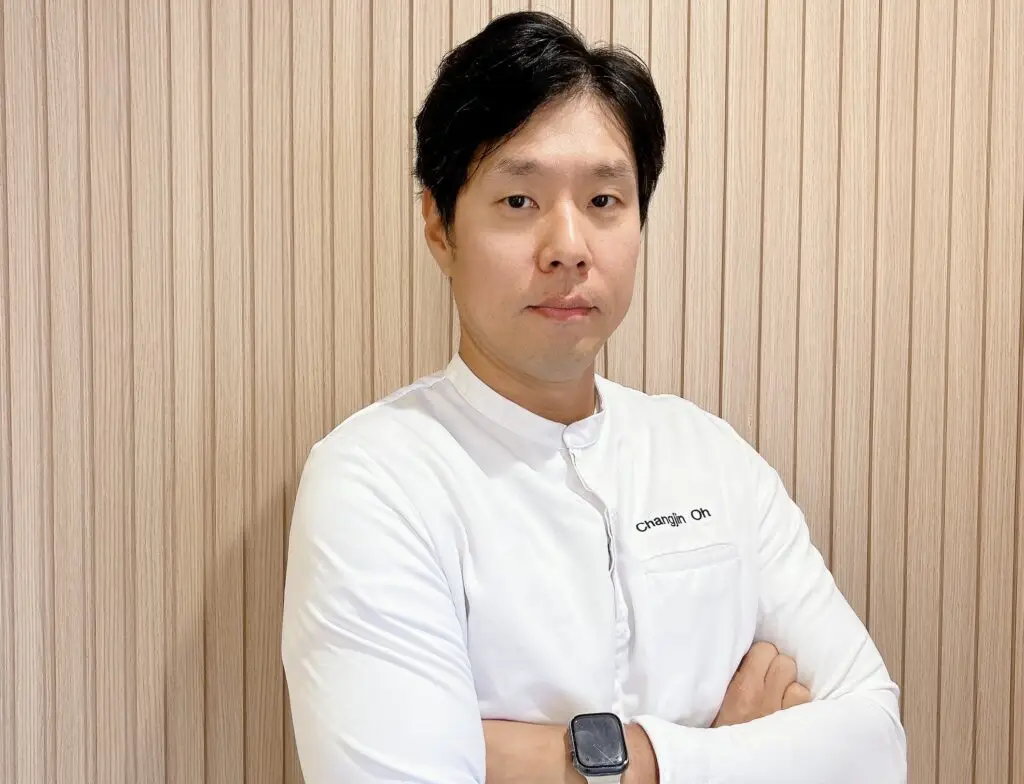
Bob Filner’s fiancee, Bronwyn Ingram
Sam Hodgson
Bronwyn Ingram
The day after Bob Filner was elected mayor of San Diego, he held the obligatory post-election press conference. He thanked his supporters, congratulated his opponent on a campaign well fought, and laid out some preliminary plans for his new administration.
Then, in response to a question about the woman at his side, Filner shot the camera his trademark grin, put his arm around her, and introduced San Diego’s next First Lady.
Bronwyn Ingram is a 48-year-old disability analyst for the Social Security Administration. She grew up in Orange County, earned a bachelor’s degree in psychology from Cal State Fullerton, and has worked for the disabled community for more than 20 years. She helped found Americans Against War with Iraq. She has traveled to Vietnam with governmental representatives and organizations to figure out how to finally rid the country of the remnants of Agent Orange.
In short, the petite, soft-spoken, driven woman is a doer.
And in January of 2012, after meditating with a monk at a Buddhist temple in Vietnam, she told Filner, 70, that she would spend the rest of her life with him.
The wedding—his third, her second—likely won’t happen until October. Ingram is expected to move from her current home in LA to San Diego when the Social Security Administration opens an office in Rancho Bernardo. Despite the delay, her relationship with Filner makes Ingram San Diego’s newest First Lady. It’s a role for which both she and Filner have big plans.
“I think you’re going to see a different First Lady,” Filner said during the November 7 press conference. “You’re going to see a team that is really aggressive and visible in terms of communities that tend to be neglected in our city.”
Unlike other major cities such as New York City and Philadelphia, San Diego hasn’t always been home to visible and active First Ladies. Even in smaller places such as Albuquerque, the First Lady, Maria Berry, is an active player in city functions. She and her team refashioned the mayor’s annual charity event into a ball that has raised half a million dollars for area organizations. She also helps survey the homeless throughout the city to determine how City Hall can serve them better.

Bronwyn Ingram
Sam Hodgson
Bronwyn Ingram
While she isn’t paid and has no designated office in City Hall, Ingram acknowledges that her association with Filner alone gives her a platform unlike any other in city politics.
Kris Michell, who heads the Downtown San Diego Partnership and served as chief of staff for Mayor Sanders until late 2010, says whatever Ingram does with that platform will be good for the homeless population, but will also be beneficial to the reputation of the city as a whole.
“I see it as a net positive for San Diego,” Michell says. “Bronwyn will have tremendous credibility. Rana Sampson had tremendous credibility… I truly just don’t see a downside. I only see upsides. In fact, it’s great.”
Sampson, the wife of former mayor Jerry Sanders, says she didn’t exactly jump headfirst into the role. She wasn’t even sure she wanted him to run in the first place.
When Sanders won, Sampson made a priority of attending mayoral events and making sure communities, nonprofit organizations, and other groups throughout San Diego knew of his commitment to them, all while she was running her own consulting business and focusing on crime reduction.
She could easily be spotted at the mayor’s annual State of the City address, initiating standing ovations for the man she says is the most extraordinary person she’s ever known.
But that first term was difficult, she says, and it made the decision to run for a second even harder.
“He felt like he could fix it if he had a little more time and that was the really, really, really hard decision… because I wasn’t in favor of that,” Sampson says. “So, like any good lawyer, I negotiated.”
Sampson cut a deal with her husband. If he won another four years at City Hall, he’d pack up at the end of the term and live with his wife in a foreign country. The two left for a three-month trip to Italy in January.
Jan Murphy, wife of former mayor Dick Murphy, had the same feelings when it came to sharing a spouse with the top office in town. Murphy was a pediatric physical therapist from Massachusetts who worked at Rady Children’s Hospital-San Diego for years. In her words, she “has always been more interested in medicine and children than government and politics.”

Bob Filner and Bronwyn Ingram
Gregory Bull
Despite her reluctant support of her husband’s choice to run for office in 2000, Murphy said she enjoyed her early years as First Lady, during which she met interesting people and attended events in support of her husband.
But, as she put it in a written statement, “the glare of the spotlight is intense.”
Murphy resigned in 2005 after being described by Time magazine as one of the three worst big-city mayors in the United States.
Both former first ladies say that dealing with criticisms of the mayor and his office is likely to be the most difficult part of taking on an active role in city politics.
Ingram’s secondary struggle will be separating the political persona from the personal relationship she has with Filner, says Sampson.
“I’m not a shy, reserved type, but I also know that I’m not the person that anybody in the city would be turning to to figure out how to… solve pension problems,” Sampson says. “Part of it is to know that’s not your role.”
To Filner, Ingram is a support system on the political front. But on a personal level, she’s the person he always looks for from the podium. Ingram recalls one campaign event at which Filner couldn’t find her from where he stood, waiting to speak to supporters. She was stuck behind a much taller onlooker, and it put Filner off his game as he tried unsuccessfully to locate her.
It’s slight and only noticeable to Ingram and Filner’s staff, but with her there, “he feels a little bit more confident. It’s just being a team together,” Ingram says.
Being a team in life and in office was always the plan.
In the two years leading up to the election, Filner, who lives in the Vantage Pointe apartments downtown, says the pair combined movie nights, dinners, and vacations with talk about what she would do if he took office.
“We talked about it the whole campaign—what would be her role,” Filner says. “We were on the streets every day trying to get a sense of how she might help and how she might do things. “
Even before the final votes were tallied in November, Filner’s aides had come up with a list of causes, issues, and ideas for Ingram to take up as her own on a volunteer basis.
“I had some people coming up to me Election Day and the day after, saying ‘We’re so excited about Mayor Bob Filner and we’re so excited to have you as First Lady. You’re going to do some great things,’” she says. “They literally said ‘We’ve already met, we’ve already been talking about some projects for you.’”
In a move that channeled her late mother, the woman she used to watch make hundreds of lunches on Sunday to distribute to those in need, Ingram picked homelessness as the issue that deserved her attention first.
She started by making weekly visits to the city’s temporary homeless shelter, touring possible sites for future affordable housing developments, and setting meetings with leaders of community organizations.
As of early December, she topped her list of homeless-eradication activities with a meeting that brought together Father Joe Carroll of Father Joe’s Villages, Bishop George McKinney of St. Stephen’s Cathedral, and representatives from Girls Think Tank, the Rotary Club, and several other groups to discuss the homelessness problem, their collective resources, and ways they could come together as a united front against homelessness.
With those resources, Filner’s position as mayor, and Ingram’s bright-eyed outlook and drive, her hope is that the anti-homelessness front is stronger than ever.
PARTNER CONTENT
“It needs all these great minds working together,” Ingram says of the issue. “There’s never been so much potential to make a serious dent in the problem as there is now.”

















